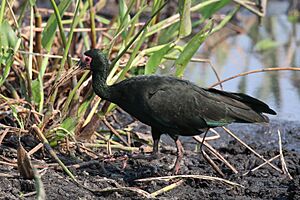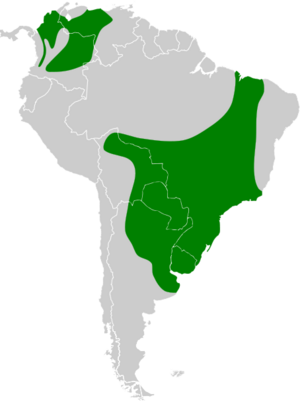Bare-faced ibis facts for kids
Quick facts for kids Bare-faced ibis |
|
|---|---|
 |
|
| P. i. nudifrons Pantanal, Brazil |
|
| Conservation status | |
| Scientific classification | |
| Genus: |
Phimosus
|
| Species: |
infuscatus
|
 |
|
The bare-faced ibis (scientific name: Phimosus infuscatus) is a unique type of bird. It's also sometimes called the whispering ibis. This bird belongs to the Threskiornithidae family, which includes other ibises and spoonbills. It's the only species in its group, called a monotypic genus, named Phimosus.
Contents
Where Do Bare-faced Ibises Live?
Bare-faced ibises can be found across many countries in South America. They live in places like Argentina, Bolivia, Brazil, Colombia, Ecuador, Guyana, Paraguay, Suriname, Uruguay, and Venezuela.
What Do Bare-faced Ibises Look Like?
The bare-faced ibis is a dark brown or blackish bird. It gets its name because it has no feathers on its face. The skin on its face is usually a reddish color. It has a long, curved beak that is pinkish to reddish-brown. Its legs are pink. These birds are about 45 to 50 centimeters long, which is about the length of a ruler.
What Do Bare-faced Ibises Eat?
Bare-faced ibises search for their food in soft soil and along the edges of water. They use their long beaks to probe for tasty treats. Their diet mainly includes insects, worms, small clams, and other tiny creatures without backbones.
Where Do Bare-faced Ibises Make Their Homes?
You can find bare-faced ibises in open, wet areas. They love places like wet meadows, savannas, marshes, and even rice fields. They usually live close to sea level. However, some have been seen in higher areas in Venezuela and Colombia.
Nesting Habits
When it's time to lay eggs, the bare-faced ibis builds a nest. They use sticks and twigs to create a safe spot. A female ibis will lay between 2 and 5 eggs. Both parents will then sit on the eggs to keep them safe and warm for up to three weeks until they hatch.
How Do Bare-faced Ibises Behave?
Bare-faced ibises are very social birds. They are often seen in large groups, sometimes with other types of ibises. They can even be found near farm animals! These birds tend to live close to other ibis groups, often within 100 meters of their neighbors.
They are not very aggressive towards other ibises. You will rarely find a bare-faced ibis all by itself. Most of the time, any aggression they show is just trying to take food from another bird or animal. When it comes to building nests, they are less aggressive than some other ibis species. They even share nesting areas with other bird species.
How Do Bare-faced Ibises Reproduce?
Bare-faced ibises usually breed in small groups. Their breeding season typically runs from August to December. They build their nests in trees or shrubs, creating platform-like structures.
A female ibis can lay anywhere from 1 to 8 eggs. The eggs are light in color, often a soft green or blue. Both the male and female ibis take turns sitting on the eggs. This incubation period lasts for about 21 to 23 days until the chicks hatch.


